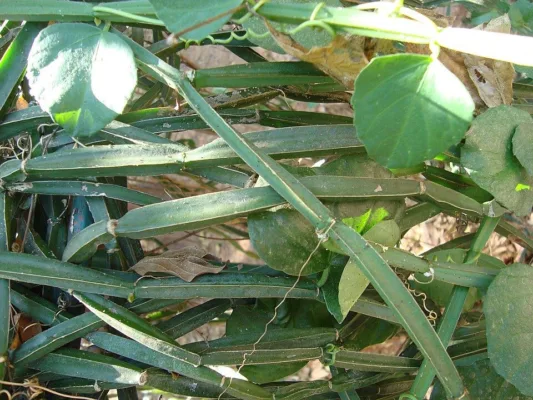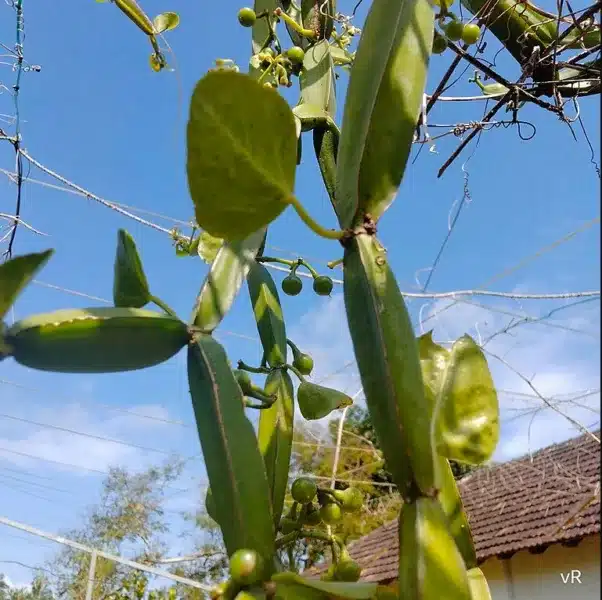Adamant Creeper: Discovering Origins, Nutrient-rich Goodness, and a Delicious Recipe for Ultimate Health
Pirandai, Vajjravalli is known in Tamil and as “Horjora”, Hadjod, Hadjora, Hadsankari, and Hadsarihari, in Hind
Origin
Adamant Creeper, known as “Devil’s Back Bone,” and “Veldt Grape” in English, is scientifically classified as Cissus Quadrangularis. This resilient perennial plant belongs to the grape family and is part of the Vitaceae family. . It is native to the Indian subcontinent, particularly in parts of India, Sri Lanka, and Bangladesh. The plant is characterized by its square stems, and it has been traditionally used in Ayurvedic medicine for various purposes. It also thrives in tropical forest regions across Asia and Africa.
Adamant Creeper has earned its intriguing nicknames due to its unique quadrangular (four-angled) stems and its reputation for resilience in challenging environments. With its widespread presence in tropical forests, Pirandai has been recognized for its various traditional and medicinal uses in different cultures.
Scientifically known as Cissus quadrangularis, it is native to the tropical forest regions of Asia and Africa. This resilient plant has its origins in these lush and biodiverse environments, where it has thrived for generations. It is particularly well-known in the Indian subcontinent, where it goes by various local names like “Horjora” in Hindi and “Pirandai” in Tamil. Pirandai’s ability to adapt and grow in these tropical climates has contributed to its prominence in traditional medicine and herbal practices across these regions.
In traditional medicine, Adamant Creeper has been employed for its potential benefits in promoting bone health, supporting joint health, and having anti-inflammatory properties. Some research has been conducted to explore these potential health benefits, although more studies are often needed to confirm and establish the efficacy of herbal remedies.
It’s worth noting that while Adamant Creeper has a history of traditional use, the scientific understanding of its properties is an ongoing field of study, and caution is advised when considering its use for medicinal purposes.
Nutrients
Adamant Creeper is a plant that boasts a variety of nutrients and bioactive compounds. Here’s a breakdown of some of the key nutrients and compounds.
Vitamins: It contains essential vitamins, including vitamin C, which supports immune health and skin vitality. It also provides a source of vitamin A, promoting eye health and overall well-being.
Minerals: This plant is rich in minerals such as calcium, phosphorus, and iron. Calcium contributes to strong bones and teeth, while iron supports the transport of oxygen in the blood.
Carotenoids: Pirandai contains carotenoids, which are natural pigments found in plants. These compounds have antioxidant properties and may help protect cells from damage caused by free radicals.
Flavonoids: Flavonoids are plant compounds with potential health benefits, including anti-inflammatory and antioxidant effects. It also contains various flavonoids that may contribute to its medicinal properties.
Resveratrol: Resveratrol is a polyphenol with antioxidant properties. While it is more commonly associated with grapes, it is also found in pirandai and may have potential health benefits.
Fiber: Contains dietary fiber, which is essential for digestive health. Fiber can aid in maintaining regular bowel movements and supporting a healthy gut.
Quercetin: Quercetin is a flavonoid known for its potential anti-inflammatory and antioxidant effects. It is present in pirandai and may contribute to its medicinal properties.
It’s important to note that Adamant creeper is often used in traditional medicine, particularly in Ayurveda, for its potential health benefits. However, more research is needed to fully understand its nutritional and medicinal properties and to determine appropriate dosages for specific health concerns. As with any herbal remedy, it’s advisable to consult with a healthcare professional before incorporating “Devil’s Back Bone” into your diet or wellness routine.
Benefits
Adamant Creeper, scientifically known as Cissus quadrangularis, is a plant that offers a range of potential health benefits when used in traditional medicine practices. While scientific research is ongoing to fully understand these benefits, here are some of the potential health advantages associated with Adamant Creeper:
Joint Health: It has been traditionally used to support joint health and alleviate discomfort associated with conditions like arthritis. Its anti-inflammatory properties may contribute to reduced joint pain and improved mobility.
Bone Health: Rich in calcium and phosphorus, Adamant Creeper may promote bone density and strength. It could be beneficial for individuals at risk of osteoporosis or those seeking to maintain healthy bones.
Digestive Aid: It contains dietary fiber, which can aid in digestive regularity and help alleviate issues like constipation. It may also support a healthy gut microbiome.
Antioxidant Properties: The plant’s antioxidants, including carotenoids and flavonoids, may help protect cells from oxidative stress and free radical damage.
Immune Support: Vitamin C found in pirandai is known for its immune-boosting properties.
Potential Anti-Inflammatory: You should know that it contains compounds like quercetin and resveratrol, which have anti-inflammatory properties. These compounds may help reduce inflammation in the body, potentially benefiting conditions linked to chronic inflammation.
Weight Management: Some traditional uses of Adament Creeper include supporting weight management and metabolism. Its potential to aid in weight loss may be attributed to its fiber content, which can promote feelings of fullness.
Skin Health: The presence of vitamins, particularly vitamin C and vitamin A, may contribute to healthier skin by promoting collagen production and skin cell regeneration.
Traditional Medicinal Uses: Adanant Creeper has a long history of use in traditional medicine systems like Ayurveda for various health concerns, including indigestion, hemorrhoids, and menstrual disorders.
It’s important to note that while pirandai offers potential health benefits, scientific research on its efficacy and safety is limited, and more studies are needed to confirm these effects. As with any herbal remedy, it’s advisable to consult with a healthcare professional before incorporating pirandai into your wellness routine, especially if you have specific health conditions or are taking medications.


